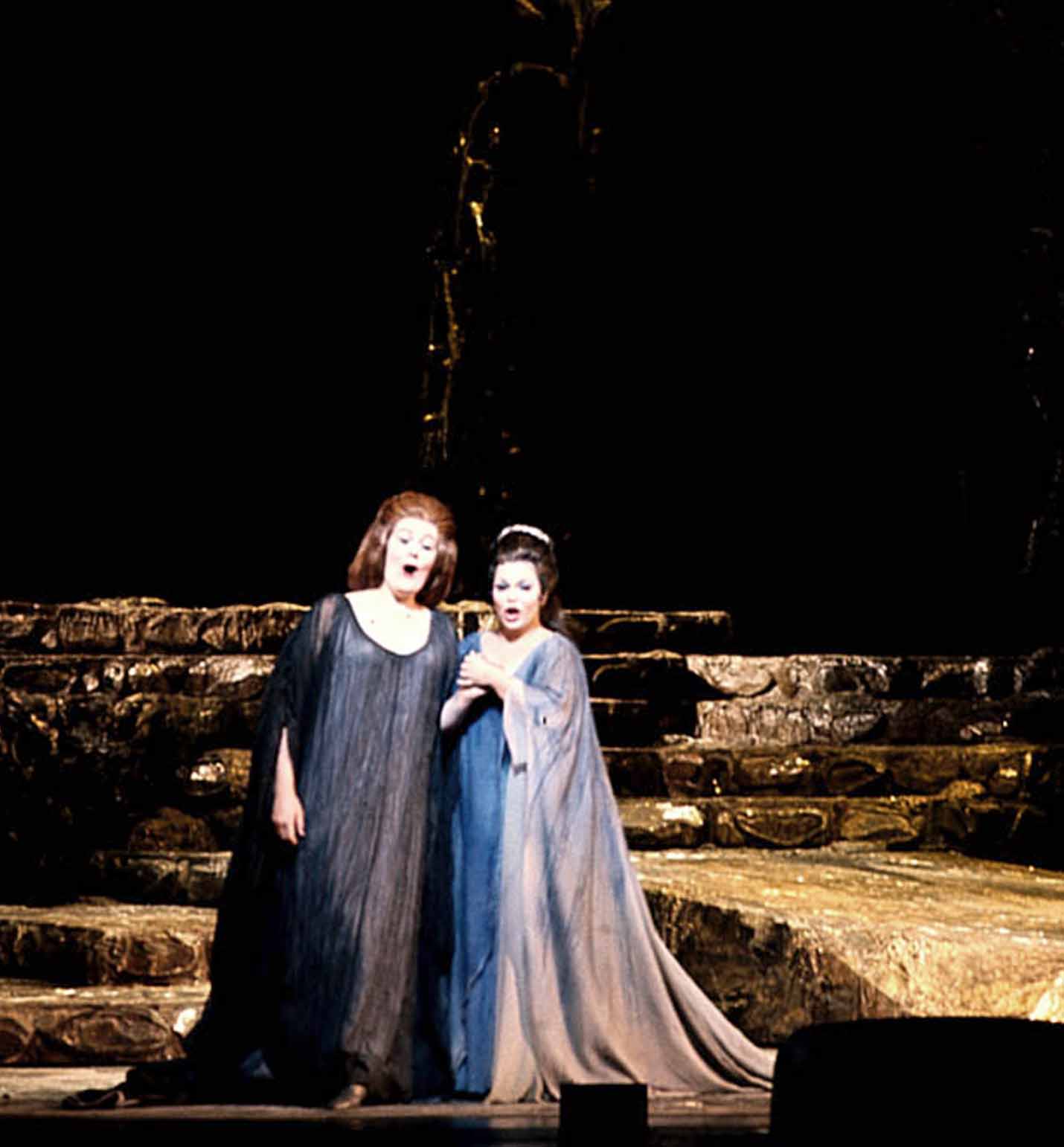Key Word Search
Multi-Field Search
Browse
Repertory Report
Performers Report
Contacts
Met Opera Website
New Production
Norma
Metropolitan Opera House, Tue, March 3, 1970
Debut : Marilyn Horne, Desmond Heeley
Norma (64)
Vincenzo Bellini | Felice Romani
- Norma
- Joan Sutherland
- Pollione
- Carlo Bergonzi
- Adalgisa
- Marilyn Horne [Debut]
- Oroveso
- Cesare Siepi
- Flavio
- Rod MacWherter
- Clotilde
- Carlotta Ordassy
- Conductor
- Richard Bonynge
- Production
- Paul-Emile Deiber
- Designer
- Desmond Heeley [Debut]
Norma received eighteen performances this season.
FUNDING:
Production a gift of Mrs. John D. Rockefeller, Jr.
Review 1:
Review of Winthrop Sargeant in The New Yorker
NORMA RECONQUERED
Olympic Games, I am told, occur every four years. At larger intervals, averaging fifteen years of so since the time of Lilli Lehmann, the Metropolitan Opera enters that olympic game of opera, Bellini's "Norma," with its champion coloratura soprano in the title role. There is no doubt in any opera buff's mind but that on November 16, 1927, with Rosa Ponselle, the Met won one of the handsomest victories in its history. In 1937, with Gina Cigna, it suffered a total defeat. Zinka Milanov, in 1943, didn't win either. In 1956 Maria Callas entered the arena. Miss Callas may be marked up as a near winner. Her musical style was impeccable, her agility tremendous, her breath control in long vocal lines admirable, and her treatment of ornamentations immaculate. The only thing she failed at was vocal quality. Her voice was already on the decline and had assumed a reedy, nasal sound. Except for this, she was magnificent, and there was the unforgettable Callas stage presence, which did a great deal to enhance the credibility of Bellini's musical drama. Last Tuesday night, Joan Sutherland joined this succession of gladiators, in a new production of the opera. Miss Sutherland, as everybody knows, has already been acclaimed a champion at lesser events, and there was much curiosity about what she would do with this role, as well as a fairly settled conviction that she would at least conquer its technical aspects. She is a dramatic coloratura soprano (unlike Beverly Sills, who is a lyric coloratura), and that is the kind of soprano that "Norma" requires - a heavyweight capable not only of singing all the "fioratura" but also of heaving great quantities of sound across the footlights.
Miss Sutherland's performance was, as might be expected, a triumph of coloratura singing. Her control of the long lines of "Casta diva" was impressive, and her agility elsewhere was very nearly flawless. There were other elements in her singing that were less pleasing, although quite familiar. Hers is a cold coloratura voice, without much emotional coloring, and she has a way of bunching her ornamentations together and hurling them out rapidly. In these matters, Miss Callas was her superior. Then there is Miss Sutherland's peculiar language, which certainly is not Italian though it resembles it here and there as it emerges thorough her faulty diction. Nevertheless, the vocalization of the role was thrilling. She hit the bull's-eye neatly with all her high notes, and her scale and arpeggio passages were, except for a couple of descending chromatic scales, brilliantly executed. Altogether, this was a first-class Norma, and the Met had won again. The feat that this involved is considerable. There are very few sopranos who can even manage to sing the role of Norma in tune and with a decent amount of vocal ornamentation. Miss Sutherland not only managed this; she even added some ornamentations of her own.
The Adalgisa of the evening was Marilyn Horne, who was making her Metropolitan début. It was high time this début occurred, for anybody who has been around singers knows that Miss Horne is, and has been for some years, one of the world's most spectacular mezzo-sopranos. From time to time, with her younger and more expressive voice, she even stole the show from Miss Sutherland, and their duets, which they had sung together many times before in other opera houses, were beautifully coördinated - particularly the finest of them, "Mira, O Norma." The Pollione was Carlo Bergonzi, that most cultivated of all contemporary Italian tenors, and he sang with a deep understanding of bel-canto style and much beauty of tone. Cesare Siepi's Oroveso was equally refined and satisfying. Even the minor roles, Carlotta Ordassy's Clothilda and Rod MacWhether's Flavio, were well done. It was an all-star night. I cannot place the conductor, Richard Bonynge, among the stars, however. His production of the score was flabby, unsteady, and a mere slavish accompaniment to the singers.
There were those who didn't like the new staging. I had no serious objections to it. The action, supervised by Paul-Emile Deiber (one of the men in charge of putting the Paris Opera back on the map) was routine and full of statuesque poses and gestures (in extenuation of Mr. Deiber's faults, it must be admitted that "Norma" is a rather statuesque opera and that it is difficult for a director to do much with it). The costumes, of the appropriate nightgown type, were by the British designer Desmond Heeley, as was the basic set - a sort of metallic-colored mini-Stonehenge, which turned one face or the other toward the audience in succeeding acts. One of the great events of the evening was the use of the turntable, for the first time, in the last act, in which, before the audience's eyes, it revolved to disclose the chorus of Druids and the scene of the funeral pyre. The Met hasn't had a workable turntable since the original one broke down during rehearsals for the [new] opera house in Lincoln Center. The new one received a small round of applause the other night.
Photograph of Marilyn Horne as Adalgisa in Norma by Louis Mélançon/Metropolitan Opera.
Photograph of Joan Sutherland and Marilyn Horne in a scene from Norma by Louis Mélançon/Metropolitan Opera.
Search by season: 1969-70
Search by title: Norma,
Met careers

